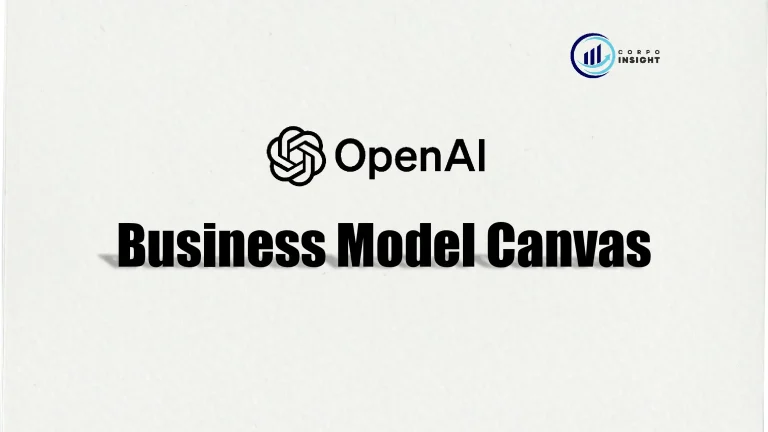Walmart Business Model Canvas 2024
Despite its humble beginnings as a single discount store in Rogers, Arkansas, Walmart has transformed itself into a retail juggernaut, with its tentacles stretching across the globe, offering a vast array of goods and services that cater to the diverse needs of millions of customers worldwide. In this Walmart Business Model Canvas, We will learn and identify its customer segments, value proposition, revenue streams, channels, customer relationships, key activities, key resources, key partners, and cost structure.
Interesting fact!
Walmart’s “Buy American” program in the 1990s led to the creation of a line of apparel made entirely from cotton grown, spun, and sewn in the United States.
Walmart Competitors
Costco | Amazon | Target | Kroger | Albertsons | Aldi | Sam’s Club | BJ’s Wholesale Club | Macy’s | Kohl’s
Customer Segments – Walmart Business Model Canvas

1. Low-to-Middle-Income Households: Walmart’s core customer base consists of households with annual incomes ranging from $20,000 to $70,000, attracted by its everyday low prices and wide assortment of essential goods, making it a go-to destination for cost-conscious shoppers seeking value for their money.
2. Rural and Suburban Residents: With a strategic focus on establishing stores in rural and suburban areas, Walmart has cultivated a loyal following among customers who may have limited access to other retail options, catering to their diverse needs with its one-stop-shopping experience.
3. Millennial and Gen Z Families: Recognizing the growing purchasing power and unique preferences of younger generations, Walmart has tailored its product offerings and digital strategies to appeal to millennial and Gen Z families, who value convenience, affordability, and sustainable practices.
4. Senior Citizens and Retirees: As a significant demographic with specific needs and preferences, senior citizens and retirees on fixed incomes find Walmart’s low-cost offerings, pharmacy services, and accessibility features particularly attractive, establishing it as a trusted retailer in this segment.
5. Multicultural Shoppers: With a commitment to diversity and inclusivity, Walmart has made concerted efforts to cater to the diverse cultural and linguistic backgrounds of its customers, offering a wide range of ethnic products, bilingual customer service, and targeted marketing campaigns.
Value Proposition – Walmart Business Model Canvas
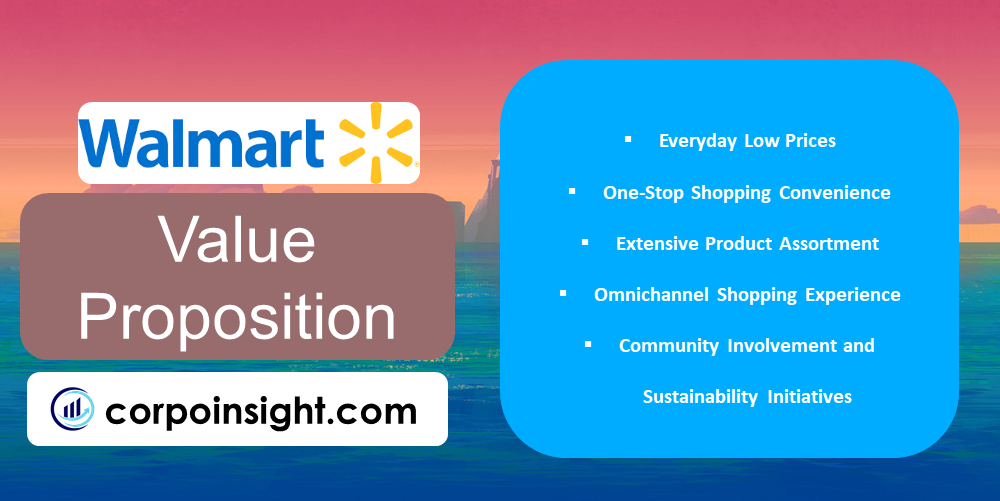
1. Everyday Low Prices: Walmart’s unwavering commitment to offering the lowest prices on a vast array of products has been the cornerstone of its value proposition, appealing to cost-conscious consumers seeking high-quality merchandise at unbeatable prices.
2. One-Stop Shopping Convenience: With its expansive retail footprint and diverse product assortment spanning groceries, apparel, electronics, and more, Walmart provides customers with the convenience of fulfilling multiple shopping needs under one roof, saving them time and effort.
3. Extensive Product Assortment: Catering to diverse consumer preferences and lifestyles, Walmart’s comprehensive product offerings, which include national brands, private labels, and exclusive collaborations, ensure that customers can find what they need, whether it’s everyday essentials or unique finds.
4. Omnichannel Shopping Experience: Recognizing the growing demand for seamless shopping experiences, Walmart has invested heavily in its e-commerce platform and buy-online-pickup-in-store options, offering customers the flexibility to shop however and whenever they choose.
5. Community Involvement and Sustainability Initiatives: Beyond its retail operations, Walmart has demonstrated a commitment to being a responsible corporate citizen by supporting local communities through philanthropic efforts, job creation, and sustainable business practices, fostering customer loyalty and trust.
Revenue Streams – Walmart Business Model Canvas

1. Retail Sales: Walmart’s primary revenue stream stems from its vast network of retail stores, where customers can purchase a wide range of merchandise, including groceries, apparel, electronics, and household goods, contributing significantly to the company’s top line.
2. E-commerce and Omnichannel Sales: Recognizing the growing importance of online shopping, Walmart has invested heavily in its e-commerce platform, enabling customers to make purchases seamlessly across multiple channels, thereby unlocking a lucrative revenue stream that complements its brick-and-mortar operations.
3. Membership and Subscription Services: To enhance customer loyalty and generate recurring revenue, Walmart has introduced membership programs like Walmart+, which offer expedited shipping, fuel discounts, and other exclusive benefits, providing a steady stream of income from subscribers.
4. Financial Services and Money Transfers: Leveraging its vast customer base and retail footprint, Walmart has ventured into financial services, offering products such as money transfers, check cashing, and prepaid debit cards, tapping into a previously untapped revenue source.
5. Advertising and Data Analytics: With its deep insights into consumer behavior and vast customer reach, Walmart has capitalized on its data-driven capabilities by offering advertising services to brands and leveraging its customer data for targeted marketing campaigns, unlocking a high-margin revenue stream.
Channels – Walmart Business Model Canvas

1. Brick-and-Mortar Stores: Walmart’s extensive network of physical retail locations, spanning supercenters, discount stores, and neighborhood markets, remains the company’s primary channel for reaching customers, offering a hands-on shopping experience and convenient access to a vast array of products.
2. E-commerce Platform: Recognizing the rapid shift towards online shopping, Walmart has invested significantly in enhancing its e-commerce capabilities, providing customers with a user-friendly platform that seamlessly integrates with its physical stores through omnichannel offerings like buy-online-pickup-in-store (BOPIS) and curbside pickup.
3. Mobile Applications: Catering to the increasing preference for mobile shopping, Walmart has developed robust mobile applications that allow customers to browse, purchase, and manage their shopping experience on the go, fostering convenience and accessibility for tech-savvy consumers.
4. Marketplace and Third-Party Sellers: To expand its product assortment and reach new customer segments, Walmart has established an online marketplace, enabling third-party sellers to list and sell their products through the company’s e-commerce platform, effectively broadening its channels.
5. Strategic Partnerships and Collaborations: Walmart has forged strategic partnerships with companies across various industries, such as grocery delivery services, technology providers, and entertainment platforms, leveraging these collaborations as alternative channels to enhance customer experiences and reach new audiences.
Customer Relationships – Walmart Business Model Canvas
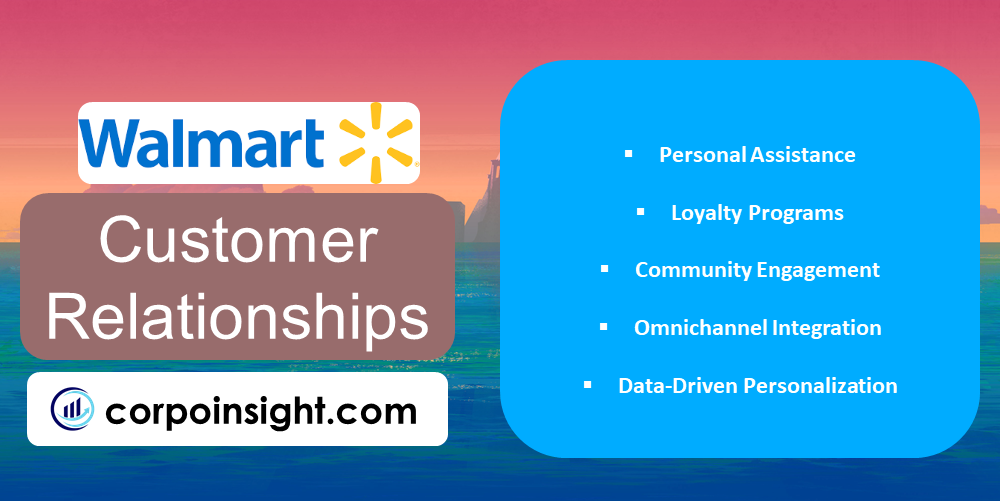
1. Personal Assistance: Walmart recognizes the importance of personalized service, offering dedicated in-store associates to assist customers with their queries, product recommendations, and overall shopping experience, fostering a sense of trust and loyalty.
2. Loyalty Programs: To cultivate long-term relationships with its customer base, Walmart has implemented loyalty programs such as Walmart+, which provide exclusive benefits, discounts, and personalized offers, incentivizing repeat purchases and enhancing customer retention.
3. Community Engagement: Walmart actively engages with local communities through philanthropic initiatives, sponsorships, and community events, fostering a sense of brand affinity and positioning itself as a socially responsible corporate citizen, thus strengthening its relationships with customers.
4. Omnichannel Integration: By seamlessly integrating its in-store, online, and mobile channels, Walmart offers customers a consistent and cohesive shopping experience, enabling them to engage with the brand on their preferred platform and fostering a strong, multi-faceted relationship.
5. Data-Driven Personalization: Leveraging its vast trove of customer data, Walmart employs sophisticated analytics to personalize marketing campaigns, product recommendations, and targeted promotions, catering to individual preferences and nurturing tailored relationships with each customer segment.
Key Activities – Walmart Business Model Canvas
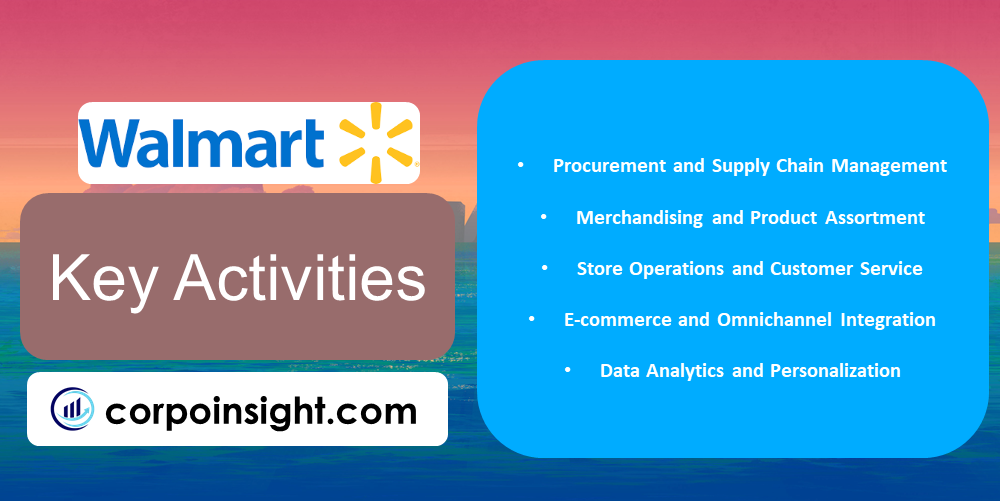
1. Procurement and Supply Chain Management: Walmart’s ability to negotiate favorable terms with suppliers and manage its vast global supply chain efficiently is a critical activity that enables the company to offer competitively low prices while maintaining profitability.
2. Merchandising and Product Assortment: Continually curating a diverse and appealing product assortment that caters to the ever-evolving preferences of its customer base is a key activity for Walmart, ensuring that it remains a one-stop shopping destination.
3. Store Operations and Customer Service: Providing an exceptional in-store experience through efficient operations, well-trained staff, and attentive customer service is a pivotal activity that underpins Walmart’s commitment to customer satisfaction and loyalty.
4. E-commerce and Omnichannel Integration: Maintaining a robust e-commerce platform, seamlessly integrating it with physical stores, and offering seamless omnichannel experiences are crucial activities that enable Walmart to meet the evolving shopping preferences of modern consumers.
5. Data Analytics and Personalization: Leveraging advanced data analytics to gain insights into customer behavior, optimize operations, and personalize marketing and product recommendations is a key activity that drives Walmart’s competitive edge and customer-centric approach.
Key Resources – Walmart Business Model Canvas

1. Extensive Physical Infrastructure: Walmart’s vast network of retail stores, distribution centers, and logistics infrastructure represents a critical resource, enabling the company to serve customers across diverse geographic regions efficiently and maintain a strong presence in both urban and rural markets.
2. Human Capital: Walmart’s highly skilled and dedicated workforce, comprising over 2.3 million associates worldwide, is a invaluable resource that underpins the company’s operations, customer service, and competitive advantage in the retail industry.
3. Brand Equity and Customer Loyalty: Walmart’s well-established brand recognition, built over decades of consistent value proposition and customer-centric approach, is a valuable intangible resource that fosters trust, loyalty, and repeat business from its extensive customer base.
4. Technology and Data Analytics Capabilities: Walmart’s substantial investments in cutting-edge technologies, such as data analytics platforms, supply chain management systems, and e-commerce infrastructure, provide the company with a competitive edge in optimizing operations and delivering personalized customer experiences.
5. Financial Resources and Buying Power: Walmart’s substantial financial resources and unparalleled purchasing power, stemming from its size and scale, enable the company to negotiate favorable terms with suppliers, invest in strategic initiatives, and weather economic downturns more effectively than its competitors.
Key Partners – Walmart Business Model Canvas

1. Suppliers and Manufacturers: Walmart’s extensive network of suppliers and product manufacturers, spanning various industries, represents a crucial partnership that ensures a steady flow of merchandise, enabling the company to offer a diverse and competitively priced product assortment.
2. Logistics and Transportation Partners: Collaborating with leading logistics providers and transportation companies is essential for Walmart, as these partnerships facilitate the efficient movement of goods across its vast distribution network, ensuring timely delivery and minimizing supply chain disruptions.
3. Technology and E-commerce Collaborators: Walmart has forged strategic partnerships with prominent technology companies and e-commerce platforms, leveraging their expertise to enhance its digital capabilities, improve customer experiences, and stay ahead of the curve in an increasingly digital retail landscape.
4. Financial Services Partners: To expand its financial services offerings and provide customers with a comprehensive range of solutions, Walmart has partnered with banks, payment processors, and fintech companies, enabling it to offer services like money transfers, check cashing, and prepaid debit cards.
5. Community and Non-Profit Organizations: Recognizing the importance of corporate social responsibility, Walmart has established partnerships with various community organizations and non-profits, working together to address societal challenges, support local economies, and foster positive impact in the communities it serves.
Cost Structure – Walmart Business Model Canvas
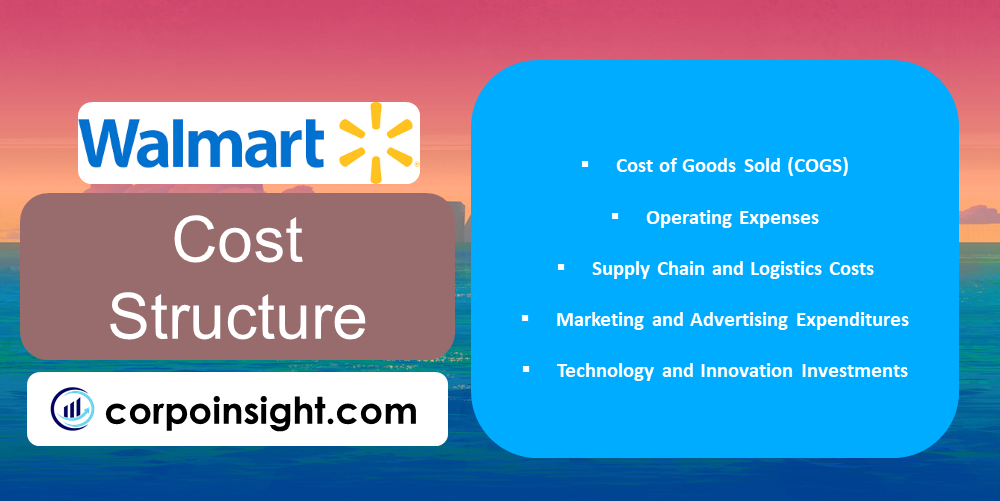
1. Cost of Goods Sold (COGS): Walmart’s largest cost component is the cost of goods sold, encompassing the procurement expenses for the vast array of merchandise it offers, including groceries, apparel, electronics, and household items, which are heavily influenced by fluctuations in commodity prices and supplier negotiations.
2. Operating Expenses: Walmart incurs significant operating expenses related to the management and maintenance of its extensive network of retail stores, distribution centers, and logistics infrastructure, including costs associated with utilities, rent, employee wages and benefits, and technology investments.
3. Supply Chain and Logistics Costs: Given the scale of Walmart’s operations and its commitment to efficient distribution, the company allocates substantial resources towards supply chain management, transportation, and inventory management, representing a significant portion of its overall cost structure.
4. Marketing and Advertising Expenditures: To maintain its brand visibility, attract new customers, and promote its offerings, Walmart invests heavily in marketing and advertising campaigns across various platforms, including traditional media, digital channels, and in-store promotions, contributing to its overall cost structure.
5. Technology and Innovation Investments: As a leader in the retail industry, Walmart continuously invests in cutting-edge technologies, such as e-commerce platforms, data analytics solutions, and automation initiatives, to drive operational efficiencies, enhance customer experiences, and maintain its competitive edge, resulting in substantial capital expenditures.
Summary of Walmart Business Model Canvas
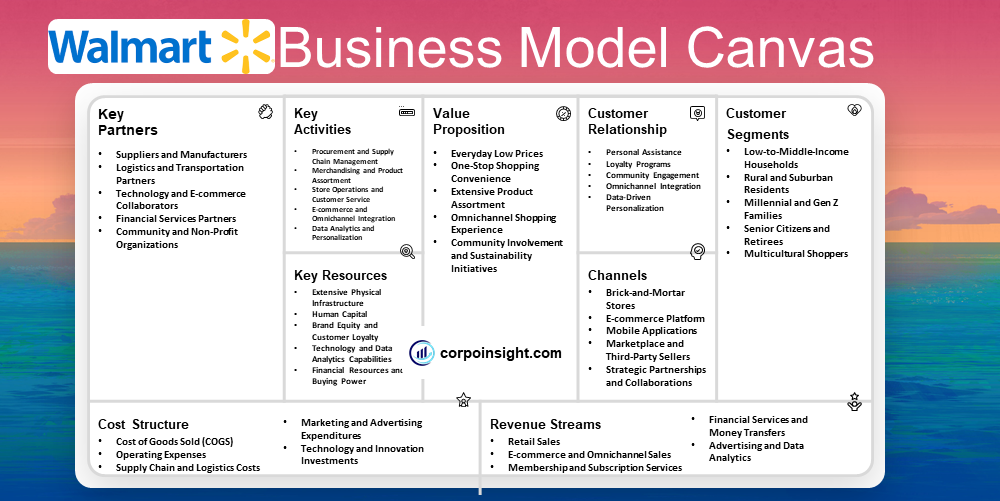
Conclusion on Walmart Business Model Canvas
Walmart’s business model canvas showcases its unwavering commitment to delivering an unparalleled value proposition through everyday low prices, extensive product assortment, and seamless omnichannel experiences. By leveraging its vast resources, strategic partnerships, and customer-centric approach, Walmart has solidified its position as a retail giant, catering to diverse consumer segments while driving operational efficiencies and sustainable growth.

I’m Samin Yasar, currently working as a Brand Strategist for one of the world’s leading Prop Firms. I have a passion for content creation and dream of making my own film one day.




